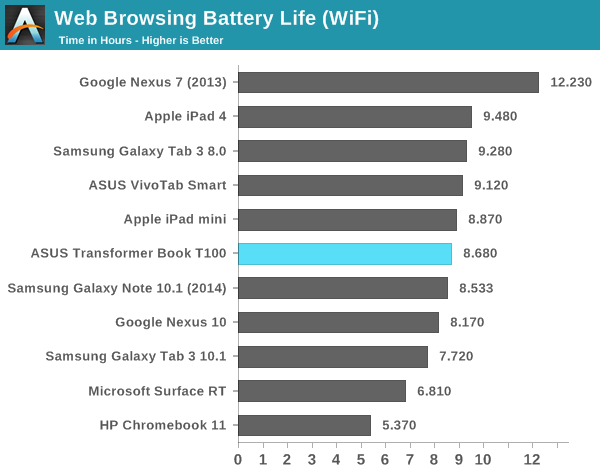ASUS Transformer Book T100 Review: Redefining the Entry-Level Windows Notebook
by Anand Lal Shimpi on October 18, 2013 12:00 AM ESTBattery Life
The Transformer Book T100 features an integrated 31Wh battery. As the keyboard dock doesn’t include an extra battery, that’s all you get. The good news is that Intel’s Atom Z3740 is built on the company’s first 22nm SoC process and it’s paired with LPDDR3. At least on the silicon front, the T100 should be fairly power efficient. Granted there are still the PMIC, display, WiFi and other components to worry about, but here’s to hoping ASUS did a reasonable job there as well.
Unfortunately ASUS delivered our T100 review sample less than 48 hours ago and I’ve been using it non-stop since then. I think I technically broke embargo by using it at a press event but it’s the only way I’d get enough time with the thing under my belt to feel comfortable writing about it. The bad news is that I only had enough time to provide a battery life teaser. I’m still running more data but for now all I’ve got is our WiFi web browsing test.
The T100’s results are presented with the keyboard dock attached and with the display calibrated to 200 nits:

Battery life looks decent at just over 8.5 hours on a single charge. In practice I had no complaints about battery life while using the device. It feels more like a tablet in that regard and less like a notebook, which is a good thing. Once again we’re seeing ASUS redefining what we’ve come to expect from an entry level notebook PC here. Even compared to Chromebooks we see the T100 do extremely well. I’m curious to get a better feel for how Bay Trail performs in the battery life department, which I’ll be doing over the coming days. So far the results look good but not quite stellar if you compare it to traditional Android/iOS tablets. I am curious to see how BT running Android would turn out.










158 Comments
View All Comments
Nagorak - Friday, October 18, 2013 - link
They both include the dock. I wish they would sell a cheaper version without the keyboard, at least as an option.AsusJake - Sunday, October 16, 2016 - link
that's the thing and I know I'm like 3 years ahead of this article, the asus t100 is not a TABLET. its a 2in1 hybrid. its a compact laptop with a removable touch screen. the other devices are just bs tabletsDrunktroop - Friday, October 18, 2013 - link
Battery Life seems acceptable, at least it stayed more or less the same as Clover Trail and being quicker at the same time.However, 2GB RAM is quite concerning here, I personally use a ThinkPad Tablet 2 at school,
which can use 1.8GB RAM with just OneNote & IE & some PDF documents.
Using Bay Trail as 32-bit SoC with 2GB RAM & Windows is not a good idea IMO,
it is not that sufficient by today standard.
ricardodawkins - Friday, October 18, 2013 - link
then buy something with 4GB of RAM or that can be upgraded. This is a 350.00 tablet.popej - Friday, October 18, 2013 - link
I agree, 2GB for Windows hardware is substandard. My 3 years old netbook supports 2GB.AsusJake - Sunday, October 16, 2016 - link
3 years later I'm still using an asus t100 now with windows 10 64 bit.... has ran and continues to 3 years after this article . ive trashed atleast 6 tabletsKhato - Friday, October 18, 2013 - link
Out of curiosity, does the Intel Power Gadget - http://software.intel.com/en-us/articles/intel-pow... - work with Baytrail? Would be quite interesting to see what it reports for package power under the various workloads if it does.Penti - Friday, October 18, 2013 - link
This is a good example why Intel's approach of really low-end devices succeeds and why Microsoft's Windows RT attempts fail. Intel gets ~30 USD, Microsoft still gets a fair share of licensing money but the user gets a full 2013 Home edition suite including damn macro/vba-support that RT doesn't provide. It supports connected standby (Surface 2 don't), but I would wait till these devices run 64-bit Windows. It does show that when they run the exact same platform and Metro is basically just the start screen that is still powered by Win32 underneath it does make RT entirely pointless. It has still better battery life than first gen RT-devices. Dock is obviously an necessity for all the Win32 apps this thing is suppose to runjhoff80 - Friday, October 18, 2013 - link
" It supports connected standby (Surface 2 don't)"Surface Pro 2 doesn't. Surface 2 (and the Surface RT, for that matter) will of course support Connected Standby.
As for macro and VBA support, it might be useful to you, but how common is that stuff in general? Seems pretty rare these days to me.
Krysto - Friday, October 18, 2013 - link
Could do without the sensationalist title.